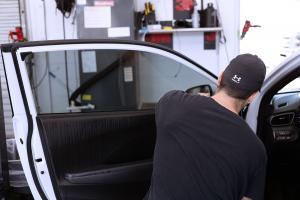
Window Tint Experts recommend drivers consider Florida’s tinting laws before darkening their windows. Window tint can keep cars cooler while increasing privacy.
— Pro Tint Orlando
ORLANDO, FLORIDA, UNITED STATES, January 30, 2023 /EINPresswire.com/ — The average driver may not be aware that the inside of a parked car can get 45 degrees hotter than the air outside in about an hour when the temperate is 95 degrees Fahrenheit.
Nowhere is this vehicle heating effect more apparent than in the sunshine state during summer.
High temperatures coupled with intense sunshine drive many Florida car owners to get their windows tinted. Contrary to popular opinion, window tinting isn’t just about making cars look cool. The right window tint can help keep it cooler by blocking out solar rays.
Experts in window tint recommend drivers consider Florida’s tinting laws before darkening their windows. If done correctly, window tinting can keep any car cooler and make it more energy efficient.
Below is a guide written by Florida window tint experts after years of experience in the field.
Why Tinting Laws Matter
Window tinting is highly regulated across the US. Each state handles auto tinting differently.
Some states don’t care if drivers tinted their windows in a state with looser regulations – it’s important to always know the tint laws when traveling to an unfamiliar area.
But why are tinting laws in place? Because window tinting directly impacts driver visibility.
If drivers could install the darkest possible film, they could limit their visibility and increase their likelihood of a car accident. Likewise, if they installed a window film that is highly reflective, it could distract or impair the visibility of other drivers on the road, creating a major hazard for everyone.
In order to address this issue, each state sets limits on how dark each window can be tinted. These limits are expressed in percentages based on how much visible light can make it through the window.
Failing to meet these tinting standards could lead to traffic violations. While the first ticket might not cost much, they get larger each time an officer writes a ticket for the same driver.
Educated drivers can avoid the risk of traffic fines by working with a Florida tinting specialist, to ensure their car meets all laws while still keeping it cool and comfortable.
Florida Window Tint Laws in 2023
The amount of light that travels through window film is expressed as visible light transmission (VLT). The lower the number, the more light is blocked out by the tinted film. A hypothetical 0% window film would block out 100% of visible light, and would be completely opaque (no visibility).
20% window tint blocks out approximately 80% of visible light, while 40% tint blocks out about 60% of visible light. Florida window tinting laws dictate what tint level is allowed for each specific window.
In the sunshine state, it is illegal to tint the entire windshield. Window film cannot be applied below the manufacturer’s AS-1 line. This line is usually visible, about five inches below the top of the windshield.
Above the AS-1 line, drivers can apply window tint as long as it’s non-reflective. On the front side windows, the tint must allow at least 28% of light through. This is true for all types of vehicles.
Rules differ for sedans versus SUVs regarding the rear side and back windows.
On sedans, rear side windows and back windows must allow 15% light through. For SUVs, rear side windows and back windows must allow 6% or more light in.
Also, window tint is not a primary offense in Florida, meaning that in order to be pulled over, drivers must already be committing another traffic violation such as speeding. This is not necessarily true for other states, though. In New Jersey, for example, having window tint that is darker than the allowed level is 100% a primary offense.
There are some medical exemptions available in Florida for those who might need a higher level of window tinting.
Reflective Window Tints
Window tints can have varying levels of reflection. Reflection helps divert sunlight away from the vehicle, preventing it from increasing the temperature inside. Reflective tint also helps to reduce glare and improve visibility.
For all Florida vehicles, front side windows can have a maximum reflection of 25%. All rear windows can have a maximum reflection of 35%.
The front windshield can not have any amount of reflection, even above the AS-1 line where tint can be applied.
Additional Florida Tinting Laws
Understanding the VLT (visible light transmission) and how much reflection is allowed on window tints is the most important aspect of Florida’s tinting laws. But there are a few other things to keep in mind before installing window tint in Florida.
If any rear windows are tinted, drivers must have dual, side-view mirrors. Because rear windows are able to be tinted darker than front windows, visibility can be lower. The laws were written so that using side-view mirrors covers any blind spots created by the tint.
Some states allow drivers to use colored tints. In Florida, all tinted windows must be black. No fancy colors allowed.
Lastly, it’s important to know that film manufacturers don’t need to certify window film in Florida. However, experts agree that driers should still purchase window film, or work with an installer that uses film from reputable suppliers that meet all state rules and regulations.
Reasons to Tint A Car in Florida
Vehicle tinting laws in Florida might seem strict, but Florida is more lenient than many other states given the extreme heat and sun drivers face every year.
In New York, for example, side windows need to allow at least 70% of light through, which is a much lower tint level than what is allowed in Florida.
Tinting keeps vehicles much cooler, especially when parked in the sun. This means the air conditioner won’t need to work quite as hard to cool down the car, saving gas and/or battery life, while preventing unnecessary wear and tear.
Window tinting also blocks out harmful UV rays, which are proven to cause sunburn. High quality window tint can make vehicles safer to drive, especially for kids in the back who may be more susceptible to sunburn. This is why many parents choose to drive an SUV, where rear side windows only need to let 6% light through, keeping kids cool and safe.
UV light can also wear out upholstery and electronics, causing the color to fade. Window tinting protects car interiors, which goes a long way to preserve value if the driver intends on selling their car in the future.
And of course, window tinting increases driver privacy. There’s no need to showcase everything to everyone on the road, naturally.
There are endless great reasons to invest in window tinting for a car, especially when dealing with Florida’s extreme heat and summer sun. By following this guide to 2023 Florida tinting laws, educated drivers can stay cool and safe in their vehicles without the risk of a traffic violation.
Auto Tint Press
Pro Tint Orlando
+1 407-841-2123
email us here
Visit us on social media:
Facebook
Instagram
YouTube
Brand New 2023 Mercedes E 450 Transformed By 3M Crystalline Window Tint – Pro Tint Orlando
The content is by EIN Presswire. Headlines of Today Media is not responsible for the content provided or any links related to this content. Headlines of Today Media is not responsible for the correctness, topicality or the quality of the content.




